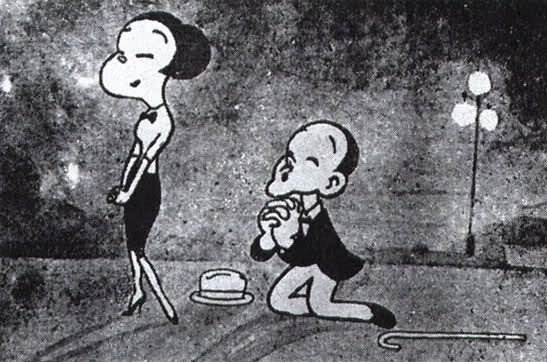The World of Power and Women (lost Japanese animated short film; 1933): Difference between revisions
m (Added "Historic" tag.) |
No edit summary |
||
| Line 5: | Line 5: | ||
|status=<span style="color:red;">'''Lost'''</span> | |status=<span style="color:red;">'''Lost'''</span> | ||
}} | }} | ||
'''Chikara to Onna no Yo no Naka''' (力と女の世の中 ''Within the World of Power and Woman'' or ''The World of Power and | '''''Chikara to Onna no Yo no Naka''''' (力と女の世の中 ''Within the World of Power and Woman'' or ''The World of Power and Women'') is a Japanese short anime film produced by Kenzō Masaoka. This anime film is the first anime to use voice acting. <ref name="animeguide">Baricodi, A.. (2000). ''Anime: A Guide to Japanese Animation (1958-1988)''. Protoculture Inc. ISBN=2-9805759-0-9 (12)</ref><ref>(1993). ''Japan: An Illustrated Encyclopedia''. Kodansha. ISBN=978-4-06-206489-7</ref> | ||
==Plot== | ==Plot== | ||
| Line 11: | Line 11: | ||
==Production== | ==Production== | ||
In 1931, Shochiku released The Neighbor's Wife and Mine (マダムと女房, Madamu to Nyōbō) which would become the first Japanese talkie film. Following the film's success, Shochiku's president, Shirō Kido, commissioned Masaoka to create the first anime to feature voice acting, and he immediately began to work on it. | In 1931, Shochiku released ''The Neighbor's Wife and Mine'' (マダムと女房, Madamu to Nyōbō) which would become the first Japanese talkie film. Following the film's success, Shochiku's president, Shirō Kido, commissioned Masaoka to create the first anime to feature voice acting, and he immediately began to work on it. | ||
Masaoka worked on the film for over a year and finally finished it in October 1932. It was released in theaters the following year on April 13, 1933. At that time, voice acting jobs didn't exist yet, so Shochiku used regular voice actors. His casting of famous stars, such as Roppa Furukawa and Ranko Sawa (of the Takarazuka Revue), helped make the film a success. | Masaoka worked on the film for over a year and finally finished it in October 1932. It was released in theaters the following year on April 13, 1933. At that time, voice acting jobs didn't exist yet, so Shochiku used regular voice actors. His casting of famous stars, such as Roppa Furukawa and Ranko Sawa (of the Takarazuka Revue), helped make the film a success. | ||
==Status== | ==Status== | ||
This anime film is considered lost, due to the absence of any available copies. All that remains are a few screenshots of scenes from the film. | |||
==External Links== | ==External Links== | ||
Latest revision as of 23:29, 6 May 2024
Chikara to Onna no Yo no Naka (力と女の世の中 Within the World of Power and Woman or The World of Power and Women) is a Japanese short anime film produced by Kenzō Masaoka. This anime film is the first anime to use voice acting. [1][2]
Plot
The protagonist is a father of four children who has a wife who has an extraordinary physique. Because of this, he had an affair with the typist at the company he worked for.
Production
In 1931, Shochiku released The Neighbor's Wife and Mine (マダムと女房, Madamu to Nyōbō) which would become the first Japanese talkie film. Following the film's success, Shochiku's president, Shirō Kido, commissioned Masaoka to create the first anime to feature voice acting, and he immediately began to work on it.
Masaoka worked on the film for over a year and finally finished it in October 1932. It was released in theaters the following year on April 13, 1933. At that time, voice acting jobs didn't exist yet, so Shochiku used regular voice actors. His casting of famous stars, such as Roppa Furukawa and Ranko Sawa (of the Takarazuka Revue), helped make the film a success.
Status
This anime film is considered lost, due to the absence of any available copies. All that remains are a few screenshots of scenes from the film.
